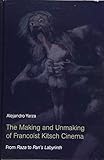The Making and Unmaking of Francoist Kitsch Cinema : From Raza to Pan's Labyrinth / Alejandro Yarza.
Material type: TextPublisher: Edinburgh : Edinburgh University Press, [2022]Copyright date: ©2017Description: 1 online resource (336 p.) : 40 B/W illustrationsContent type:
TextPublisher: Edinburgh : Edinburgh University Press, [2022]Copyright date: ©2017Description: 1 online resource (336 p.) : 40 B/W illustrationsContent type: - 9780748699247
- 9780748699230
- online - DeGruyter
| Item type | Current library | Call number | URL | Status | Notes | Barcode | |
|---|---|---|---|---|---|---|---|
 eBook
eBook
|
Biblioteca "Angelicum" Pont. Univ. S.Tommaso d'Aquino Nuvola online | online - DeGruyter (Browse shelf(Opens below)) | Online access | Not for loan (Accesso limitato) | Accesso per gli utenti autorizzati / Access for authorized users | (dgr)9780748699230 |
Frontmatter -- Contents -- Figures -- Acknowledgments -- Preface -- Introduction -- CHAPTER 1 The Petrified Tears of General Franco: Kitsch and Fascism in José Luis Sáenz de Heredia’s Raza -- CHAPTER 2 Romancero Marroquí and the Francoist Kitsch Politics of Time -- CHAPTER 3 Los últimos de Filipinas: The Spatio-temporal Coordinates of Francoism -- CHAPTER 4 Surcos: Neorealism, Film Noir, and the Puppet Master -- CHAPTER 5 Franco, ese hombre: From Kitsch-Artist to Kitsch-Man -- CHAPTER 6 Viridiana: The World, the Flesh, and the Devil -- CHAPTER 7 Balada triste de trompeta: Of Ghosts and Clowns -- CHAPTER 8 Under the Sign of Saturn: The Labyrinth of Moral Choices in Francoist Spain -- Works Cited -- Index
restricted access online access with authorization star
http://purl.org/coar/access_right/c_16ec
Examines Francoist and Post-Francoist Spanish cinema through the lens of kitsch aestheticsIn fascist Spain, Francoism – like German and Italian fascism – produced its own particular brand of kitsch. Deploying religious and historical iconography drawn from Spain’s centuries-long struggle against Islam, Francoist ideologues created a kitsch interpretation of Spain’s historical past designed to replace more complex and nuanced accounts, where religious and historical iconography combined with kitsch aesthetics to project a picturesque, clichéd image of Spain. The ultimate goal of this vast production of Francoist kitsch was to produce a submissive subject who, by identifying with Francoist aesthetics, would identify with state ideology.This book engages with the making and unmaking of Francoist kitsch aesthetics through the analysis of Spanish cinema. It examines five highly influential Francoist films produced from 1938 until 1964 and three later films by critically acclaimed directors Luis Buñuel, Guillermo del Toro, and Alex de la Iglesia that attempt to undermine Francoist aesthetics by re-imagining its visual and narrative clichés.Key featuresA comprehensive analysis of totalitarian kitsch aesthetics and Spanish fascismAn exploration of the links between cinema and politics in Franco and Post-Franco SpainIn-depth film analysis of several Spanish films anchored in historical contextsTheoretical approach to Spanish cinema and kitsch aestheticsClose analysis of films by critically acclaimed directors Luis Buñuel, Alex de la Iglesia and Guillermo del Toro
Mode of access: Internet via World Wide Web.
In English.
Description based on online resource; title from PDF title page (publisher's Web site, viewed 29. Jun 2022)


